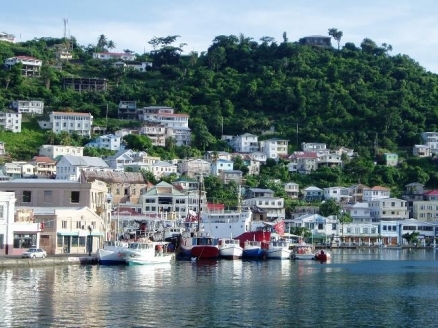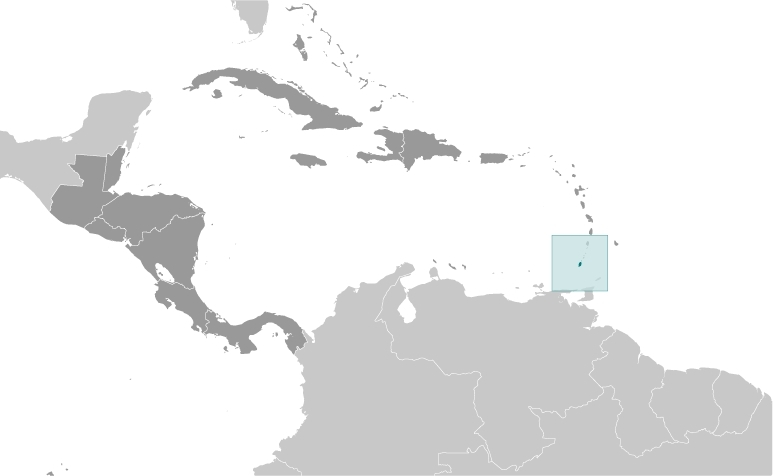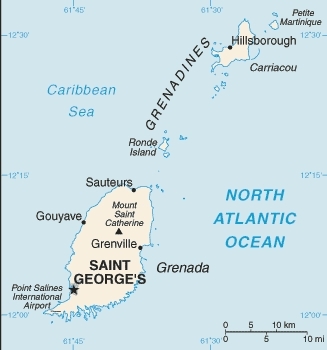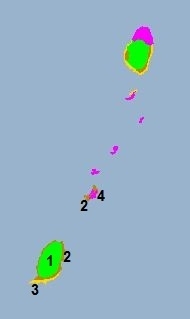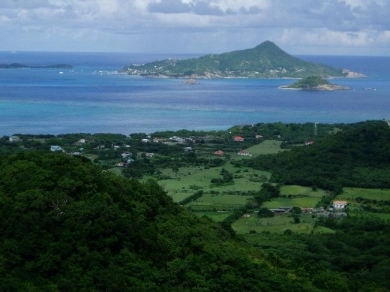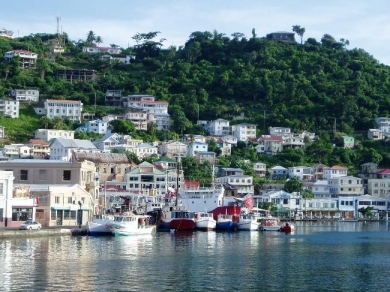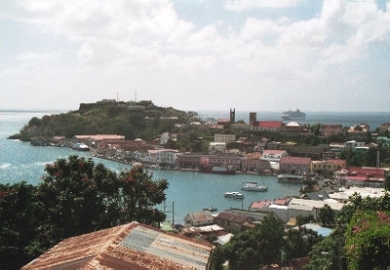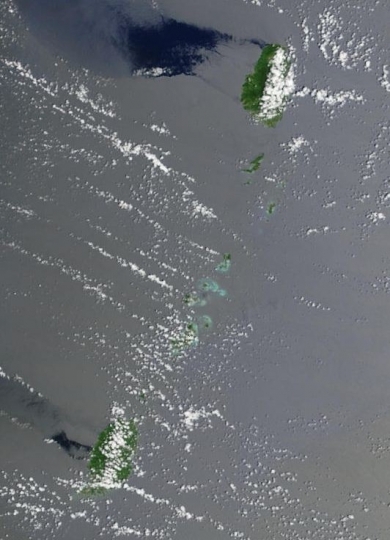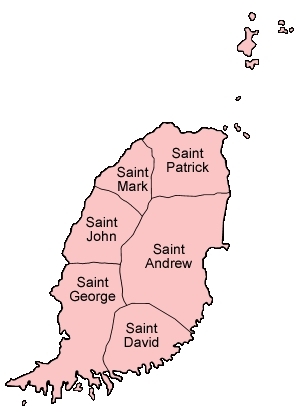Grenada
Countries and Regions of the World Collection  Grenada is a nation on 109,000 people composed of one major island and much smaller islands (part of the group known as the Grenadines) located in the southeast Caribbean Sea.
Grenada is a nation on 109,000 people composed of one major island and much smaller islands (part of the group known as the Grenadines) located in the southeast Caribbean Sea.
Grenada is located at longitude 61° 4' W and latitude 12° 4' N, situated 110 kilometers (km) southwest of Saint Vincent and 145 km north of Trinidad and Tobago. It is the most southerly of the Windward Islands.
The largest island, Grenada (311 km2), is 34 km long and 19 km wide, with two much smaller islands Carriacou (34 km2), and Petit Martinique (3.2 km2), thereby giving a total land area of 348.2 km2.
Grenada is mostly volcanic in origin, of steep rugged topography, with a main mountain chain running almost north-south in two main sections.
Grenada is part of the Grenadines group which is divided between Saint Vincent and the Grenadines (the northern half) and Grenada (the southern half).
The island is subdivided into seven parishes, six on Grenada with Carriacou and Petit Martinique together constituting the seventh.Grenada is part of the island group referred to as the Lesser Antillies and part of the region known as the Caribbean or the West Indies.
Carib Indians inhabited Grenada when Columbus discovered the island in 1498, but it remained uncolonized for more than a century.
The French settled Grenada in the 17th century, established sugar estates, and imported large numbers of African slaves.
Britain took the island in 1762 and vigorously expanded sugar production.
In the 19th century, cacao eventually surpassed sugar as the main export crop; in the 20th century, nutmeg became the leading export.
In 1967, Britain gave Grenada autonomy over its internal affairs. Full independence was attained in 1974, making Grenada one of the smallest independent countries in the Western Hemisphere.
In 1983 a Marxist military council took control of Grenada and, six days later, the island was invaded by US forces and those of six other Caribbean nations.
Free elections were reinstituted the following year and have continued since that time.
Hurricane Ivan struck Grenada in September of 2004 causing severe damage.
Contents
Geography
Location: Between the Caribbean Sea and Atlantic Ocean, north of Trinidad and Tobago
Geographic Coordinates: 12 07 N, 61 40 W
Area: 344 square km
arable land: 5.88%
permanent crops: 29.41%
other: 64.71% (2005)
Coastline: 121 km
Maritime Claims: Territorial sea to 12 nautical miles and an exclusive economic zone to 200 nautical miles
Natural Hazards: Grenada lies on edge of hurricane belt; hurricane season lasts from June to November.
Terrain: Volcanic in origin with central mountains. The highest point is Mount Saint Catherine (840 meters).
Climate: Tropical; tempered by northeast trade winds.
Ecology and Biodiversity
|
1. Mosts of the main island of Grenada is covered byWindward Islands moist forests. The ecoregion is very high in terms of biological richness and diversity (Species diversity), and also has abundant flora and fauna. Due to its restricted size, distribution and similarity to the moist forest ecoregion however, little information exists regarding plants and animals specific only to this area. 2. The eastern coast of Grenada and part of the south is included within the Windward Islands dry forests ecoregion. The ecoregion is characterized by steep topography and is most often found in the intermediate area between the rugged interior-island mountains and the flatter, xeric coastal areas. This dry forest ecoregion is sparsely distributed among the Windward Island Group of the Caribbean’s Lesser Antilles. It is commonly found as an intermediate gradient between the moister, high-elevation forests and the xeric, coastal areas. Much of this ecoregion has been dramatically altered by shifting cultivation. Many areas that were once dry evergreen or semi-evergreen seasonal forest, are now cultivated and dominated by farms, rural villages, roads, pastures and banana stands. This ecoregion shares flora and fauna with adjacent moist forests and, in some areas, with species native to coastal habitats. Arid coastal areas and inaccessible interior mountains put a disproportionate amount of human-related pressures (i.e., agricultural expansion, roads, buildings, etc.) on this ecoregion. Consequently, conservation attention is of particular importance in these dry forests. 3. The southern coast of Grenada is covered by Caribbean shrublands. 4. The smaller islands are covered by Bahamoan-Antillean mangroves for the most part, with some Windward Islands dry forests |
Ecoregions of the Grenadines with those of present in Grenada numbered. Source: World Wildlife Fund |
Grenada has one established protected area (Grand Etang Forest Reserve), however, there is no substantive national park legislation that provides adequate authority either to establish or to manage national parks and protected areas.
People and Society
Population: 109,011 (July 2012 est.)
About 89% of Grenada's population is of African descent. An additional 8.2% are of mixed East Indian, African, and/or Caucasian ancestry, reflecting Grenada's history of African slaves, East Indian indentured servants, and European settlers. An additional 2% of the population considers itself East Indian, which includes some descendents of the indentured servants brought to Grenada from 1857 to the 1890s, as well as immigrants arriving from Trinidad and Tobago, Guyana, and Indians since the 1970s. A small community (less than 1% of the population) of the descendants of early European settlers resides in Grenada. About 60% of Grenada's population is under the age of 25. English is the official language; few people still speak French patois, though there has been a recent resurgence of interest in re-learning the language. A wide range of Christian denominations are present in Grenada, as well as growing number of other religions.
Age Structure:
Median age:22.8 years
0-14 years: 25.4% (male 14,152/female 13,390)
15-64 years: 65.7% (male 36,245/female 34,960)
65 years and over: 8.9% (male 4,372/female 5,300) (2011 est.)
| Photo taken from the island of Carriacau, part of Grenada. The island visible on the horizon is Petit Martinique, also part of Grenadan territory. |
| A view of Fort Rupert as seen from the entry to the harbor of St. George's. |
| St. George's in 2000. Source: Wikimedia Commons. |
|
The Grenadines. St. Vincent is at top and Grenada at bottom. Source: NAS |
Population Growth Rate: 0.538% (2012 est.)
Birthrate: 16.81 births/1,000 population (2012 est.)
Death Rate: 7.98 deaths/1,000 population (July 2012 est.)
Net Migration Rate: -3.45 migrant(s)/1,000 population (2012 est.)
Life Expectancy at Birth: 73.3 years
male: 70.76 years
female: 76.09 years (2012 est.)
Total Fertility Rate: 2.15 children born/woman (2012 est.)
Languages: English (official), French patois
Literacy: (age 15 and over can read and write) 96% (2003 est.)
Urbanization: 39% of total population (2010) growing at an annual rate of change of 1.6% (2010-15 est.)
History
Before the arrival of Europeans, Carib Indians had driven the more peaceful Arawaks from the island. Columbus landed on Grenada in 1498 during his third voyage to the new world. He named the island "Concepcion." The origin of the name "Grenada" is obscure, but it is likely that Spanish sailors renamed the island for the city of Granada. By the beginning of the 18th century, the name "Grenada," or "la Grenade" in French, was in common use.
Partly because of the Caribs, Grenada remained un-colonized for more than 100 years after its discovery; early English efforts to settle the island were unsuccessful. In 1650, a French company founded by Cardinal Richelieu purchased Grenada from the English and established a small settlement. After several skirmishes with the Caribs, the French brought in reinforcements from Martinique and defeated the Caribs.
The island remained under French control until its capture by the British in 1762, during the Seven Years' War. The Treaty of Paris formally ceded Grenada to Great Britain in 1763. Although the French regained control in 1779, the Treaty of Versailles restored the island to Britain in 1783. Britain overcame a pro-French revolt in 1795, and Grenada remained British for the remainder of the colonial period.
During the 18th century, Grenada's economy underwent an important transition. Like much of the rest of the West Indies it was originally settled to cultivate sugar, which was grown on estates using slave labor. But natural disasters paved the way for the introduction of other crops. In 1782, Sir Joseph Banks, the botanical adviser to King George III, introduced nutmeg to Grenada. The island's soil was ideal for growing the spice, and because Grenada was a closer source of spices for Europe than the Dutch East Indies the island assumed a new importance to European traders. The collapse of the sugar estates and the introduction of nutmeg and cocoa encouraged the development of smaller landholdings, and the island developed a land-owning yeoman farmer class. Slavery was outlawed in 1834.
In 1833, Grenada became part of the British Windward Islands Administration. The governor of the Windward Islands administered the island for the rest of the colonial period. In 1958, the Windward Islands Administration was dissolved, and Grenada joined the Federation of the West Indies. After that federation collapsed in 1962, the British Government tried to form a small federation out of its remaining dependencies in the Eastern Caribbean.
Following the failure of this second effort, the British and the islands developed the concept of associated statehood. Under the Associated Statehood Act of 1967, Grenada was granted full autonomy over its internal affairs in March 1967. Full independence was granted on February 7, 1974.
After obtaining independence, Grenada adopted a modified Westminster parliamentary system based on the British model, with a governor general appointed by and representing the British monarch (head of state) and a prime minister who is both leader of the majority party and the head of government. Sir Eric Gairy was Grenada's first Prime Minister.
On March 13, 1979, the New Joint Endeavor for Welfare, Education, and Liberation Movement (New Jewel Movement--NJM), ousted Gairy in a coup and established a People's Revolutionary Government (PRG) headed by Maurice Bishop, who became Prime Minister. His Marxist-Leninist government established close ties with Cuba, the Soviet Union, and other communist bloc countries.
In October 1983, a power struggle within the government resulted in the arrest and execution of Bishop and several members of his cabinet and the killing of dozens of his supporters by elements of the People's Revolutionary Army (PRA).
A U.S.-Caribbean force landed on Grenada on October 25, 1983, in response to an appeal from the Governor General and to a request for assistance from Barbados and other Eastern Caribbean states. U.S. citizens were evacuated, and order was restored.
An advisory council named by the Governor General administered the country until general elections were held in December 1984. The New National Party (NNP) led by Herbert Blaize won 14 out of 15 seats in free and fair elections and formed a democratic government. Grenada's constitution had been suspended in 1979 by the PRG, but it was restored after the 1984 elections.
The NNP continued in power until 1989 but with a reduced majority. Five NNP parliamentary members, including two cabinet ministers, left the party in 1986-87 and formed the National Democratic Congress (NDC), which became the official opposition.
In August 1989, Prime Minister Blaize broke with the NNP to form another new party, The National Party (TNP), from the ranks of the NNP. This split in the NNP resulted in the formation of a minority government until constitutionally scheduled elections in March 1990. Prime Minister Blaize died in December 1989 and was succeeded as Prime Minister by Ben Jones until the elections.
The NDC emerged from the 1990 elections as the strongest party, winning seven of the 15 available seats. Nicholas Brathwaite added two TNP members and one member of the Grenada United Labor Party (GULP) to create a 10-seat majority coalition. The Governor General appointed him to be Prime Minister.
In parliamentary elections on June 20, 1995, the NNP won eight seats and formed a government headed by Keith Mitchell. The NNP continued to hold power for the next 13 years, with varying levels of representation in parliament, taking all 15 parliamentary seats in the January 1999 elections and 8 of 15 seats in the November 2003 elections. The National Democratic Congress (NDC) led by Tillman Thomas established itself as the official opposition.
Keith Mitchell lost his bid to win an unprecedented fourth term in the July 2008 election. While he won his own seat by a huge margin, only three other NNP candidates were voted in a very close election. Tillman Thomas led his NDC cohort to an 11 to 4 victory over their longtime rivals. Mitchell is now the leader of the official opposition.
In February 2007, the Privy Council in London handed down its verdict on the appeal of the group that was convicted of murdering Prime Minister Bishop and members of his cabinet in 1983. The "Group of 14" were originally condemned to death, but the sentence was commuted to life in prison. The three triggermen, sentenced to 30 years in prison as they were following orders, were released in December 2006 after serving two-thirds of their original sentence, as per local law. The remainder of the group argued that the original trial was unjust and appealed to the Privy Council to overturn the verdict and sentence. The Privy Council decision, however, only vacated the sentence, on the grounds that the original death sentence was inappropriate. It upheld the convictions of multiple homicides, stripping the group of its political prisoner status. On resentencing, the Grenada Supreme Court overturned the life sentences. Three of the 13 remaining after the resentencing were released from prison in 2007, with the final group of 10 released in the summer of 2009.
Government
Grenada is governed under a parliamentary system based on the British model; it has a governor general, a prime minister and a cabinet, and a bicameral parliament with an elected House of Representatives and an appointed Senate.
Grenada's constitution provides citizens with the right to change their government peacefully. Citizens exercise this right through periodic free and fair elections held on the basis of universal suffrage.
The political parties in Grenada are the governing left-of-center National Democratic Congress (NDC), which incorporated former members and associates of the New Jewel Movement (NJM); the moderate New National Party (NNP); the People's Labor Movement (PLM), which is a combination of members of the original NDC and the Maurice Bishop Patriotic Movement (MBPM); and the Grenada United Labor Party (GULP). The National Party (TNP) and MBPM no longer exist. The Good Old Democracy Party (GOD) has only one adherent but contests all elections.
|
Government Type: Parliamentary democracy and a Commonwealth realm Capital: Saint George's - 40,000 (2009) Administrative Divisions: 6 parishes and 1 dependency*:
Independence Date: 7 February 1974 (from the UK) Legal System: based on English common law. Grenada has not submitted an International Court of Justice (ICJ) jurisdiction declaration; and is a non-party state to the International Criminal court (ICCt) |
International Environmental Agreements
Grenada is party to international agreements on Biodiversity, Climate Change, Climate Change-Kyoto Protocol, Desertification, Endangered Species, Law of the Sea, the Ozone Layer Protection, and Whaling.
Water
Water resources originate mainly from a system of permanent streams and rivers but there is some groundwater available from the limestone areas along the northwest coast. The entire population (rural and urban) has access to the domestic water supply. About 80% of the island is connected to the public water supply, 7% to standpipes while the remainder is supplied from rain water catchments. However, there is very little available from that supply that can be diverted to agriculture. Irrigated agriculture is largely undeveloped in Grenada. The irrigation potential has not been quantified and though there is water available from a number of surface and groundwater sources, these sources have not been tapped nor is the extent of this resource known.
Resources
Natural Resources: Timber, tropical fruit, deepwater harbors
Economy
The economy of Grenada, based primarily upon services (tourism and education) and agricultural production (nutmeg and cocoa), was brought to a near standstill by Hurricane Ivan on September 7, 2004. Thirty-seven people were killed by the hurricane, and approximately 8,000-10,000 left homeless. Hurricane Ivan damaged or destroyed 90% of the buildings on the island, including some tourist facilities. Hurricane Emily swept over the island 10 months later, wreaking further havoc. Overall damage totaled as much as 2.5 times annual GDP. Reconstruction proceeded quickly, with the United States as the leading donor, with an emergency program of about $45 million aimed at repairing and rebuilding schools, health clinics, community centers, and housing; training several thousand Grenadians in construction and other fields; providing grants to private businesses to speed their recovery; and providing a variety of aid to help Grenada diversify its agriculture and tourism sectors.
Despite initial high unemployment in the tourist and other sectors, urban Grenadians benefited post-hurricane from job opportunities in the construction sector. Agricultural workers did not fare as well. Hurricane Ivan destroyed or significantly damaged a large percentage of Grenada's tree crops, and Hurricane Emily further damaged the sector. The hurricanes exacerbated an ongoing exodus out of the rural areas to the country's cities and towns as young Grenadians increasingly chose not to farm. Complete recovery will take years. Most hotels, restaurants, and other businesses reopened by 2007. In anticipation of the April 2007 Cricket World Cup matches held on the island, many Grenadians renewed their focus on the rebuilding process. Predictions for an increase in tourism were realized in part, although Grenada lags behind its neighbors in marketing the island abroad, particularly in the largely untapped U.S. market. St. George's University, a large American medical and veterinary school with about 3,700 graduate and undergraduate students, is in full operation.
Grenada is a member of the Eastern Caribbean Currency Union (ECCU). The Eastern Caribbean Central Bank (ECCB) issues a common currency for all members of the ECCU. The ECCB also manages monetary policy, and regulates and supervises commercial banking activities in its member countries.
Grenada is also a member of the Caribbean Community and Common Market (CARICOM). Most goods can be imported into Grenada under open general license, but some goods require specific licenses. Goods that are produced in the Eastern Caribbean receive additional protection; in May 1991, the CARICOM common external tariff (CET) was implemented. The CET aims to facilitate economic growth through intra-regional trade by offering duty-free trade among CARICOM members and duties on goods imported from outside CARICOM. In the spring of 2008, due to dramatic increases in the costs of food and fuel, the government removed the CET from some essential items, including baby formula, yeast, and baking powder. The country suffered greatly from the global economic downturn, which reduced tourism arrivals. Although the country replanted many nutmeg trees, the lag between planting and bearing fruit has left Grenada with fewer resources than hoped. The government reintroduced the value added tax in 2010.
Grenada has rebounded from the devastating effects of the hurricanes but is now saddled with the debt burden from the rebuilding process. Public debt-to-GDP is nearly 110%, leaving the Thomas administration limited room to engage in public investments and social spending.
Strong performances in construction and manufacturing, together with the development of tourism and an offshore financial industry, have also contributed to growth in national output. However, economic growth remained stagnant in 2010-11 after a sizeable contraction in 2009, because of the global economic slowdown's effects on tourism and remittances.
GDP: (Purchasing Power Parity): $1.428 billion (2011 est.)
GDP: (Official Exchange Rate): $800 million (2011 est.)
GDP- per capita (PPP): $13,300 (2011 est.)
GDP- composition by sector:
agriculture: 10.6%
industry: 28.9%
services: 60.5% (2011 est.)
Industries: Food and beverages, textiles, light assembly operations, tourism, construction
Exports: Bananas, cocoa, nutmeg, fruit and vegetables, clothing, and mace.
Imports: Food, manufactured goods, machinery, chemicals, fuel
Currency: East Caribbean dollars (XCD)
Further Reading
- Water profile of Grenada, Food and Agriculture Organization.
